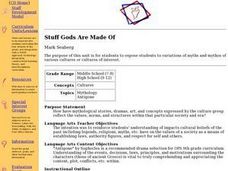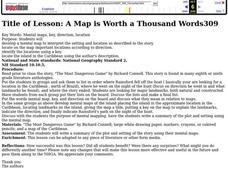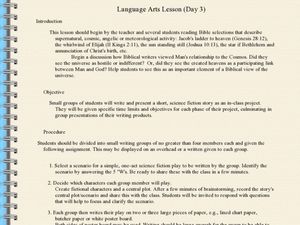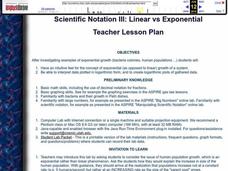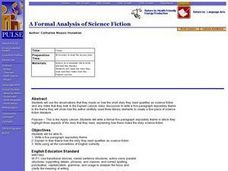Curated OER
Cell Phone Plans
Students relate the use of a cell phone to math. In this algebra instructional activity, students collect data on the usage of their phones and plot it. They analyze the graph and make predictions based on the rate per minute.
Curated OER
Stuff Gods Are Made Of
Students examine different myths of various cultures around the world. Using artwork, they discuss the artistic designs and develop hypothesize about their importance. They use the internet to research myths they are aware of and share...
Curated OER
Decades of Drama
Students explore, examine and study August Wilson's 10-play series where each play focuses on a particular decade. They discuss each play in depth and then speculate on the possible plots for an eleventh play set in the 21st century.
Curated OER
Freak the Mighty Vocabulary/Question Journal Ch. 13-25
In this novel study worksheet, students review the vocabulary and plot structure of chapters 13-25 of Freak the Mighty as they respond to 21 fill in the blank and short answer questions.
Curated OER
The Box Problem
Students create graphic, algebraic and verbal ideas of functions. In this algebra lesson, students graph functions and identify the zeros of the functions. They find the domain and range and classify functions as relation or not.
Curated OER
Atomic Bomb Debate
Students research the decision to end World War II by dropping the atomic bomb. For this world history lesson, students explore information on the atomic bomb and the decision of the tactics to use it. They also watch a video...
Curated OER
Conflict and Cooperation
Learners investigate conflict resolution. In this world conflict lesson, students examine the roles of NATO, the UN, and the EU in diplomacy issues. Learners look into the conflict in the Balkans that prompted the Bosnian War.
Curated OER
How Do Values Shape Conflicts?
High schoolers work through conflict. In this conflict resolution lesson, students participate in a simulation that requires them to consider both sides of the whaling issue.
Curated OER
A Map is Worth a Thousand Words
Students read the story, "The Most Dangerous Game," by Richard Connell. They discuss specific parts of the story with a group and put their lists on the board. They write a summary of the plot and setting of the story.
Curated OER
A Long Time Ago in the Future
Pupils read and discuss Canadian young adult literature. They compare/contrast the elements of citizenship, characterization, and themes, write journal responses, and identify the elements that define Canadians.
Curated OER
Bible Readings: Supernatural, Cosmic, Angelic, Meteorological
Students create and present a short science fiction story. For this Bible studies lesson students work in small groups and are assigned characters and a scenario to develop a play about.
Curated OER
"The Hell of Mirrors" by Edogawa Rampo
Students read and analyze the short story, "The Hell of Mirrors," by Edogawa Rampo. They write diary entries, develop a video, create an illustration, conduct research, and write a short story.
Curated OER
Scientific Notation III: Linear vs Exponential
Students examine the differences in exponential growth and linear growth of a system. They interpret data on graphs and develop their own charts. They answer discussion questions as well.
Curated OER
A Formal Analysis of Science Fiction
Students write a five paragraph expository theme. They explain in their theme how the story they read qualifies as science fiction. Students write using all the conventions of English correctly.
Curated OER
Journey to the Center of the Earth I
Students identify the elements of science fiction and write their own example. In this Journey to the Center of the Earth lesson students complete several activities about science fiction, authors and novels.
Curated OER
Global Awareness
High schoolers read about how scientists are arriving at current theories of human origin and migration through mitochondrial DNA analysis. They then piece together a map showing the data from mitochondrial DNA analysis to plot the...
Curated OER
The Window
Students read a story entitled, "The Window," and discover how some cultures are rejected by others. Students write a letter expressing feelings of rejection and keep a journal of significant events in the story. Using a graphic...
Curated OER
Good Brother, Bad Brother
Learners are exposed to the writings of John Wilkes Booth. They discover that fanaticism is not just a modern phenomenon. They examine four periods in American history when treason was at issue.
Curated OER
Missed The Boat
Learners complete time and distance problems. Using appropriate problem solving strategies, students determine when a helicopter will catch a cruise ship. Learners write a summary of their solution process. They complete a graph to...
Curated OER
Classic Short Stories- Locked Room Settings
Students read the short story "The Problem of Cell 13" and examine the plot devices that build suspense. In this lesson students create their own short story using the same locked room setting.
Novelinks
The Tempest: A-Z Book Project
Create a picture dictionary for one of William Shakespeare's most famous plays. After readers finish The Tempest, they assign each letter of the alphabet to a concept or character, and add a description and evidence from...
Curated OER
Theatre- The Critic's Review
Students construct a critical review of a performance. For this theatrical lesson, students learn why critical reviews are important and create their own critical review. Students discuss their review.
Curated OER
Exploring the Nature of Conflict
Students define conflict and violence, and determine the difference between the two. They find positive aspects of conflict while analyzing a conflict which they experienced. They organize their thoughts using a webbing activity.
San José State University
MLA Formatting Guidelines: Ellipsis for Omissions
If you would like a concise overview of MLA formatting, this two-page handout provides it. It addresses page layout, parenthetical citations, and works cited (including when and how to use ellipses to indicate an omission), but it does...

